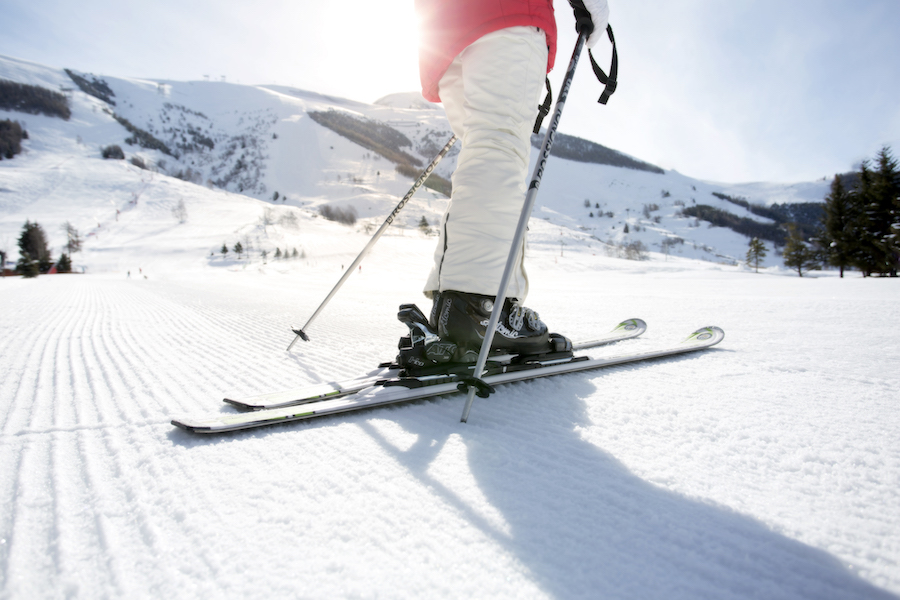7 things you should know before buying your own skis this winter
Competent skiers who hit the slopes more than once a season could avoid hours queuing at resort rental stores by investing in skis of their own.
But buying your own kit can be a daunting process, so where do you start?
Here’s what you need to know.
1. It all depends on your preferred ski surface

Going off piste? You’ll want wider skis to tackle the deep snow
Depending on whether you’ll be carving up the piste or mainly skiing through powder, you’ll need different skis.
Ian Davis, Head of Winter at Neilson ski holidays, says: “A ski used for piste skiing will be narrower under your boot and will have a greater side cut or shape, meaning it will turn more quickly on piste. Off-piste skis are wider, allowing you to float more in softer conditions.”
And if you see the mountain as a playground, and every bump and lip as an opportunity to show off some tricks, you should consider different skis again.
“Look for a ‘twin tip’ style ski which will allow you to ski backwards as well as forwards. They may also be a slightly lighter construction which means they are easier to control in the air,” Ian says.
2. Different skis are suitable for intermediate and advanced levels

Sam Castleton from online mountain equipment shop Serial Skier says: “The greater skill set of an advanced skier means they can adapt their technique much more readily between different styles. An intermediate who can handle a middle of the road ski for cruising groomed pistes may well struggle on a small radius carving ski that cuts tight technical turns. They might also struggle to handle a fat freeride ski that is considerably wider underfoot.
“The good news for intermediates is that with the latest technologies and rockered shapes (curved tips and tails), the majority of mountain-style skis will suit everybody’s piste and off-piste requirements.”
3. Your height and weight makes a difference when it comes to ski length
In the dark about why some people’s skis are longer than others? “A taller, heavier person will normally have a longer ski. It is more stable at speed but if it is too long for your weight and ability it can be more difficult to turn,” Ian says. “So they’re not a good option for beginners.”
4. There are gender-specific skis

Who knew men and women needed different types of skis?
“Ladies’ [skis] are generally lighter than men’s and are less stiff,” explains Ian.
Traditionally, the centre of gravity is slightly further forward on women’s skis too, which is to do with the difference in leg-to-torso proportions and upper-to-lower leg proportions. When a female skier flexes forward in her boots, the centre of gravity has more chance of shifting backwards.
5. Prices vary enormously
It’s possible to pick up skis for as little as £100, and for as much as £2,000. So how much do you actually pay for a decent pair?
“Spending over £350 will get you a good pair of skis. Top of the range models are around £600-plus, and there are some premium brands that retail in the thousands. They aren’t necessarily better than other skis but they are an exclusive brand,” Ian says.
“My go-to skis this winter are the Salomon QST 99 – which I use for pretty much everything. I also have a pair of Salomon Xrace Lab 175, which are amazing for hacking around the piste at warp speed.
While Sam says: “If you shop around and look for last winter’s 16/17 stock in sale sections, you could be owning a new pair of great skis from as little as £221…not a bad deal at all when you consider the price of rental for a week in some of the major resorts these days.
“The best deals will involve purchasing the skis as a package with bindings…and the best shops will mount these to your boot size and requirements at no extra charge.”
6. Buying skis at a resort could be a sensible option

It might actually be worth waiting until you’re on holiday to buy skis. Ian says: “Most shops in ski resorts allow you to test out a pair of skis free of charge, providing you then buy a pair at the end of the week. This will allow you to try out a few types before you invest.”
You could even take a lesson and discuss the best options with an instructor, who’ll be able to give you another perspective by analysing how you ski.
7. You can’t use the same pair of skis forever
Don’t assume you can save money by buying a pair of skis to use for the rest of your life, because they won’t last that long.
“Replacing your skis depends how hard and how much you are using them, and how much of an aggressive skier you are,” says Ian. “As a general rule of thumb, a pair of skis should easily do 20 weeks [on the slopes].”
The Press Association
Latest posts by The Press Association (see all)
- 5 surprising things you can clean in the washing machine - January 9, 2025
- Prince William posted a heartfelt birthday message to ‘most incredible wife and mother’ - January 9, 2025
- Birthday wishes for Catherine from royal family as the Princess of Wales turns 43 - January 9, 2025
- Maple Cinnamon Granola - January 8, 2025
- 8 things your feet can tell you about your health - January 8, 2025





















